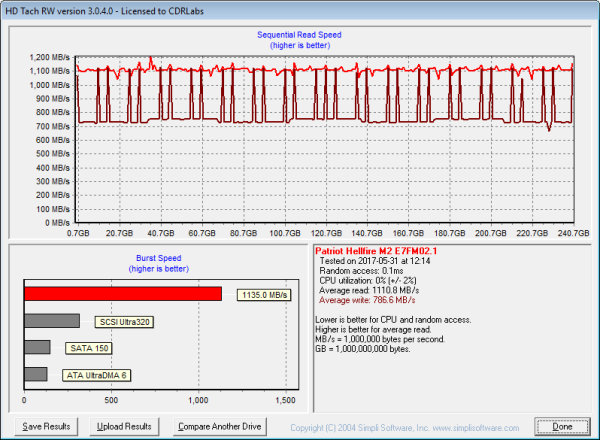TRIM Performance:
While SSD's offer many benefits, there are some downsides to using flash memory. One of the biggest issues people run into is performance degradation. Over time, an SSD will run out of fresh blocks and will have to write over data the file system has marked as deleted. This procedure is very complicated and can slow an SSD's write speeds considerably.
To fix this problem, most manufacturers have added TRIM support to their SSDs. The TRIM command allows an operating system, such as Windows 7, to tell an SSD which data blocks are no longer in use. Using this information, the drive pro-actively erases these blocks and adds them to the free block pool.

To test the Hellfire's TRIM and garbage collection functions, I first put the drive in a "dirty" state. I used Iometer to fill the entire drive and then ran a random write test for 30 minutes. Looking at the screenshot below, you can see that the Hellfire's average read and write speeds dropped to 312.6 MB/s and 690.5 MB/s, respectively.

Patriot Hellfire - Dirty
To see how well the Hellfire could recover, I let the computer sit for about 30 minutes and then reran the test. The drive wasn't able to reach the factory fresh performance shown in our earlier tests. However, its average read speed jumped up to 1110.8 MB/s.

Patriot Hellfire - After TRIM
Lastly, I used Parted Magic to perform a secure erase on the Hellfire. With the drive wiped clean, it had average read and write speeds of 1128.2 MB/s and 812.1 MB/s, respectively.

Patriot Hellfire - Secure Erased
Final Thoughts:
Since its release, the Patriot Hellfire has received a lot of positive press and, as you saw in our review, it's well deserved. This compact, M.2 form factor SSD is powered by Phison's PS5007-E7 controller and is available with up to 480GB of Toshiba's 15nm MLC NAND flash. Combine this with an NVMe 1.2 certified, PCIe Gen3 x4 interface and you have a drive capable of delivering nearly four times the performance of your average SATA 6Gb/s SSD. In our sequential read and write tests, the 240GB version of the drive was able to read at speeds as high as 2,967 MB/s and write at speeds in excess of 2,281 MB/s. The Hellfire also did very well in our random write tests, producing more than 214,000 IOPS at low queue depths.
That being said, the Hellfire is not without its down sides. Like other Phison PS5007 based SSDs, it tends to run a bit hot. Under normal workloads, the drive's temperature stayed below 56°C, but when pushed hard, it jumped up as high as 92°C. This probably won't be an issue if you have a desktop computer with plenty of airflow but it's something to keep in mind if you're looking to put the the drive in a laptop. The Hellfire's PS5007 controller also handles incompressible data differently than it does compressible data. As a result, you will see slower write speeds when working with data that is already compressed like most audio, video and image file formats.
The Patriot Hellfire is available now in 240GB and 480GB capacities. The 240GB version reviewed here currently retails for about $130. Otherwise, if you need more storage, the 480GB model can be picked up for less than $240 on Amazon.com..
Highs:
- PCIe 3.0 x4 interface with NVMe protocol
- Available in 240GB and 480GB capacities
- Equipped with Toshiba 15nm MLC NAND
- Good sequential and random read and write performance
- Small M.2 2280 form factor
- Large DRAM cache
- Reasonably priced
- 3 year warranty
Lows:
- Not as fast when writing incompressible data
- Can run hot under heavy workloads
- Does not support hardware based encryption
- Not available in a 960GB capacity

